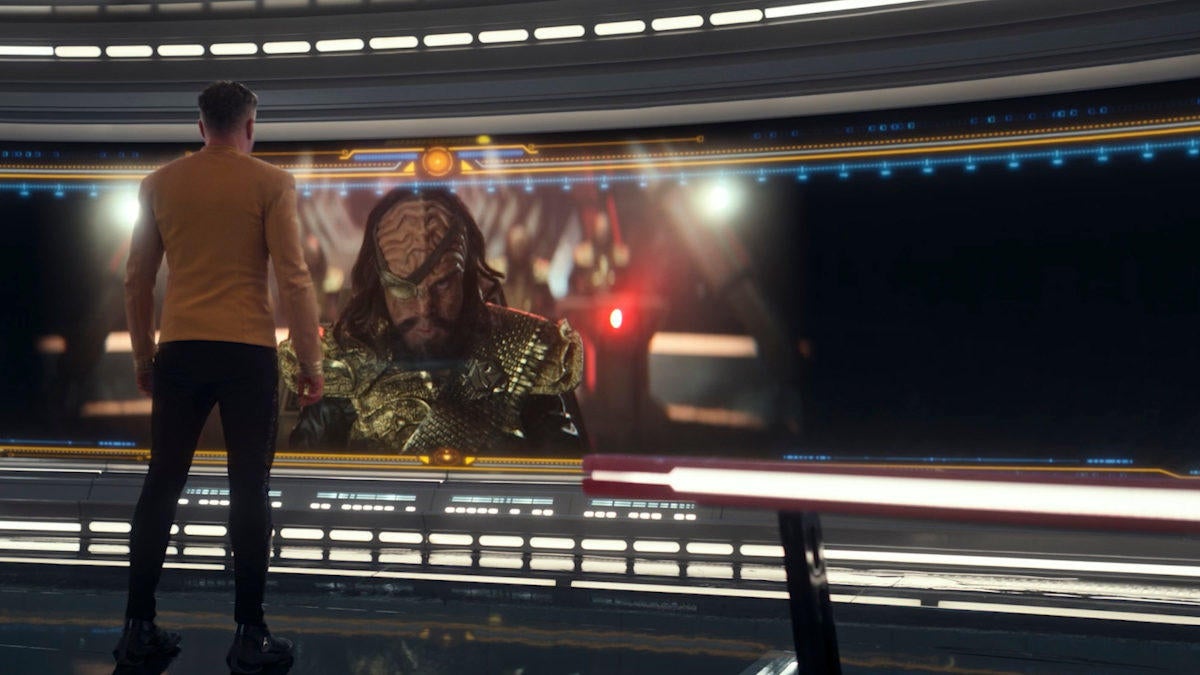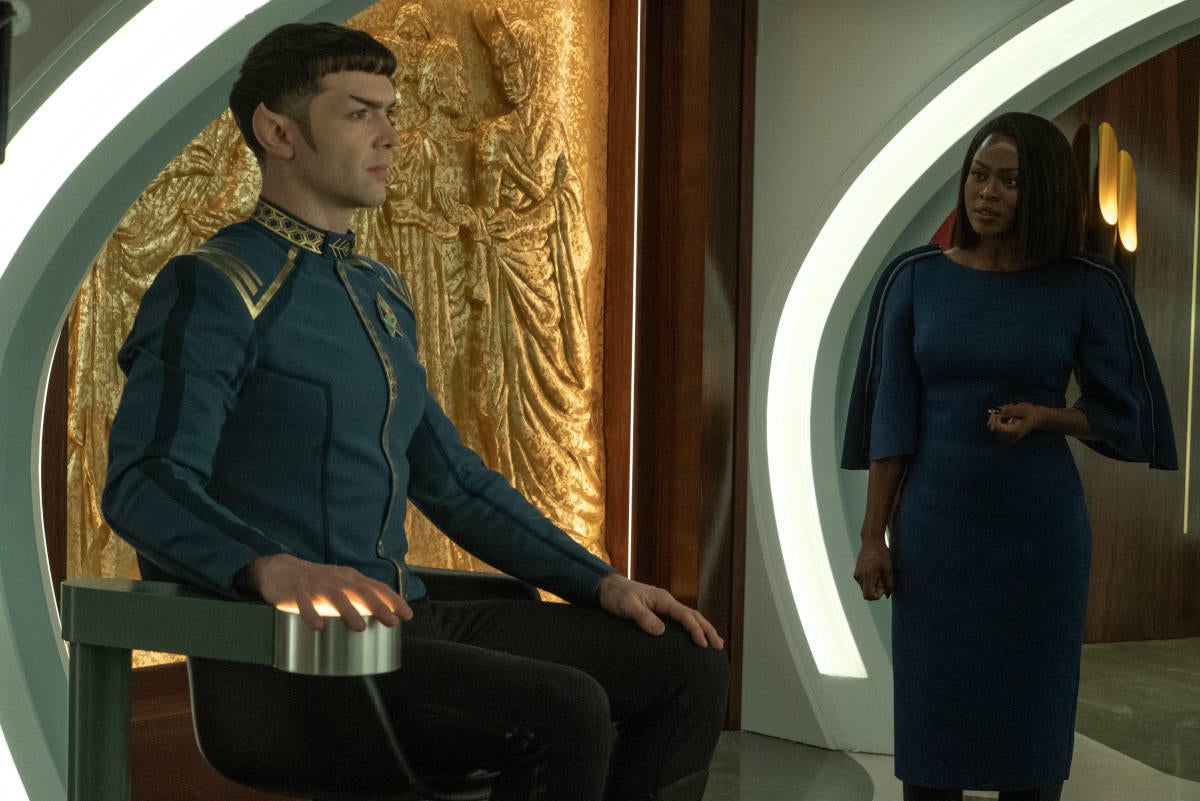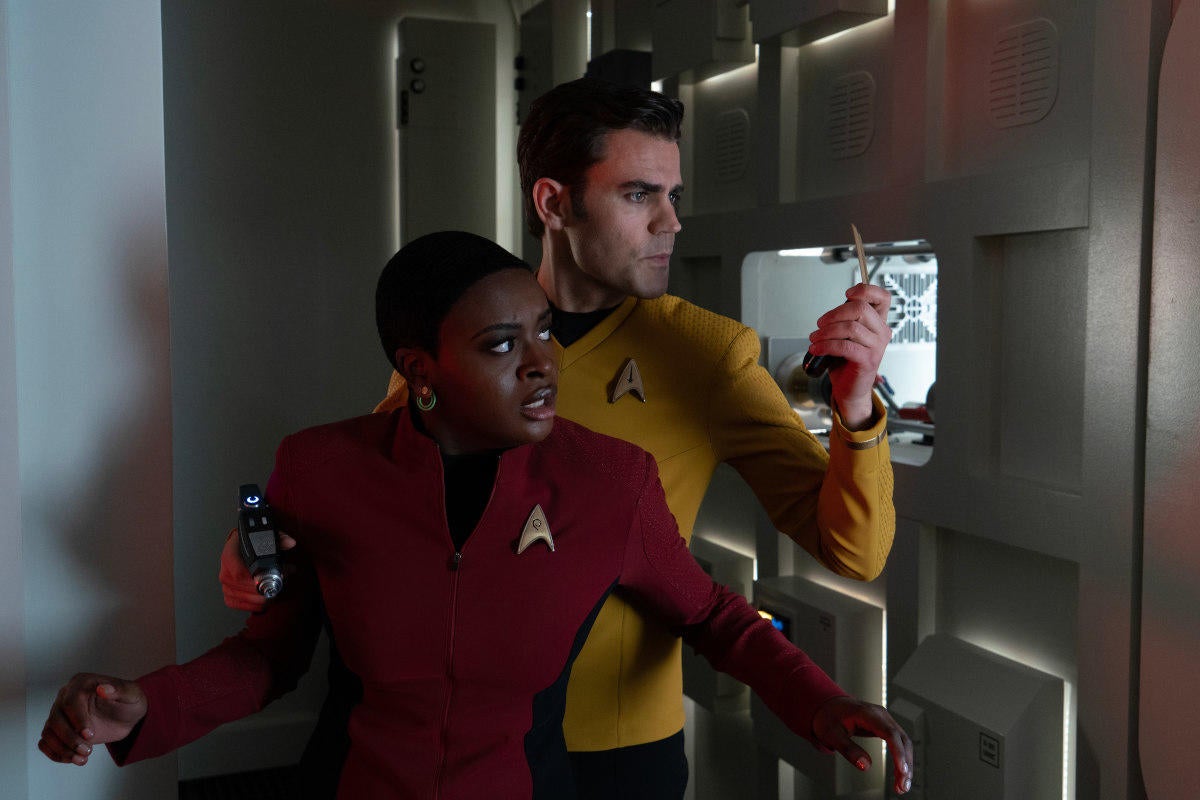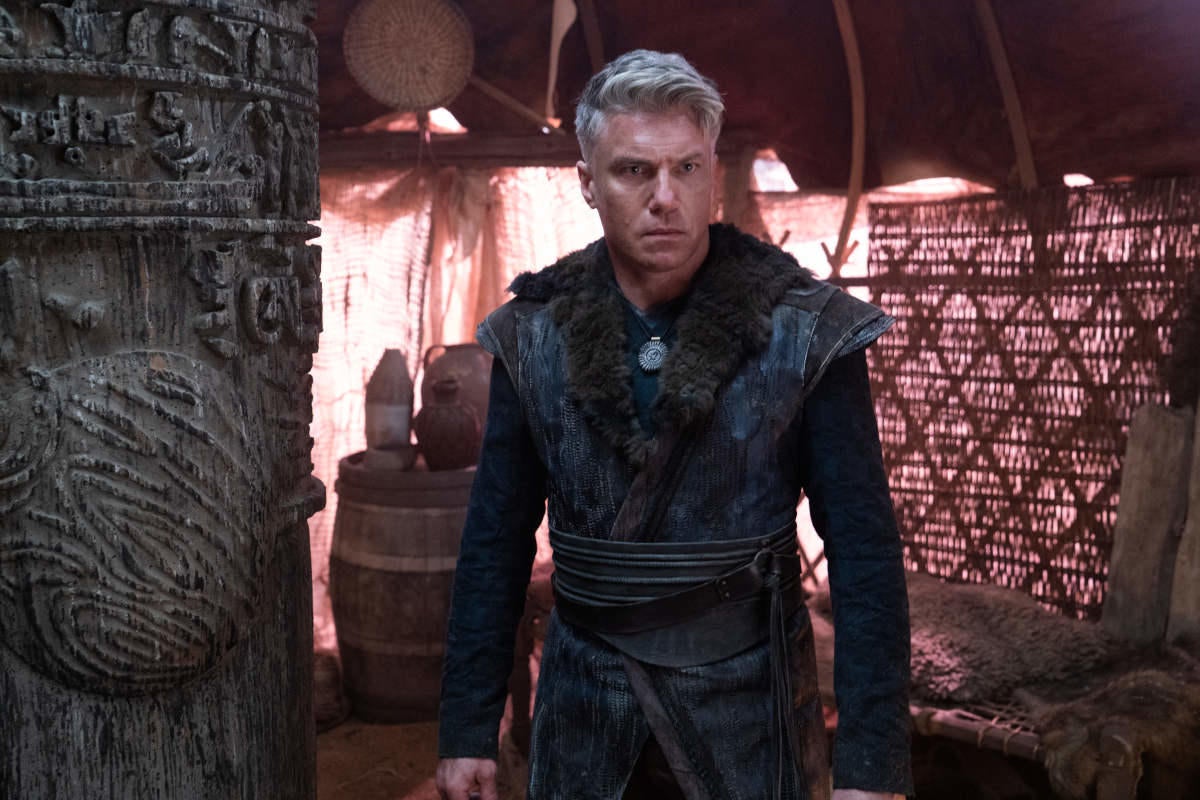Star Trek: Strange New Worlds Cinematographer on Season 2's Many Genres and the One He Still Wants to Make
Strange New Worlds' Benji Bakshi on the volume's challenges and the joy of genre-hopping.
Star Trek: Strange New Worlds – Season Two beams down to Blu-ray, DVD, and 4k Ultra HD Blu-ray today, giving fans a new way to watch all 10 of the latest adventures of Captain Pike and the Enterprise crew. That includes "Those Old Scientists," the crossover episode featuring characters from Star Trek: Lower Decks, and "Subspace Rhapsody," Star Trek's first-ever musical episode. That's a small sampling of the varied genres that Star Trek: Strange New Worlds – Season Two tackled, ranging from courtroom drama to star-crossed time travel romance to tense political mystery-thriller. That episodic approach is part of what has endeared Star Trek: Strange New Worlds to fans.
Ensuring that each episode's distinct genre comes across requires a holistic approach from the various departments that work on the Paramount+ series. That includes the talents of cinematographer Benji Bakshi, who joined Star Trek: Strange New Worlds in its second season as one of several directors of photography who worked on different episodes. Having come from a feature film background, Bakshi applied his experience to episodes like the legal drama "Ad Astra per Aspera," the medieval adventure "Among the Lotus Eaters," the ship-bound episode "Lost in Translation," and the musical event that was "Subspace Rhapsody." ComicBook.com spoke to Bakshi while Star Trek: Strange New Worlds was still being released about how he approached the series. Here's our conversation:

Watching some of the behind-the-scenes features for Star Trek: Strange New Worlds, there's a lot of talk about how the show uses the volume video wall in mixed sets, like engineering, and how that allows for some very cool opportunities but also comes with some unique challenges. Where do you come into that process, given that they have to figure out what the volume's going to look like weeks if not months ahead of time for scenes? What additional challenges do you face working with the volume and how do you make it work?
Benji Bakshi: I came into the show, Season 2, and Season 1 was set up by a cinematographer named Glenn Keenan, and he also has a Star Trek Discovery background, so he was working with the showrunners, Akiva [Goldsman] and Henry [Alonso Myers], and setting things up in a new way because this show has a very distinct tone that's different from some of the other shows. To be honest, I think there were a lot of struggles with the volume in the first season and also, this is typical of first seasons that sometimes you're watching the paint dry on a brand-new set trying to shoot it, and all these things. To my pleasure, coming in Season Two, they had, thankfully, gone through their journey and worked a lot of this stuff out. They also started on a great tone with the show. That inspired me to take it from there into Season 2. I did collaborate with Glenn and another cinematographer named Ian Anderson on Season Two.
With that said, each episode is completely made from scratch, if you will. The ship is always the ship, but even recurring sets we might shoot them and light them in different ways. We have the freedom to do that, and each episode is, basically, its own genre. In creating the worlds, we are usually three to four months in advance of the shooting schedule for making these volume worlds. Sometimes we are working on less specific script content at that point, and we work towards more and more specific needs for what the episode will have.
The beauty of this series is the level of specificity that the greater creative team puts in. That starts from Akiva and Henry, from the top, really understanding the content that they're writing, understanding the audience who they're writing to, and having a huge knowledge base of Star Trek so that they're fitting into this prequel slot in a way that will honor what has come after, but also feels fresh and giving the audience something unexpected. Every single person who's creatively adding to that is tip-toeing the balance between pure creativity and freedom versus the obligation of honoring the Star Trek world in all its history.
Speaking of how every episode tends to be a different genre, which is certainly part of Star Trek: Strange New Worlds' appeal. I imagine even though they feel like different genres, you want some level of consistency, to ensure it still looks like the same show that audiences watched the previous week. Or do you? How far can you push that envelope as far as making each episode look distinct before you break the established feel of the show? Or have you been encouraged to just go for it, and we'll let that itself out as it progresses?
There are definitely discussions that we've had with the showrunners, with Chris Fisher who's the producing director, who's one of the lead creative roles on the show, and who works with each incoming director on each episode and directs some of them himself, namely the premieres. We really have full creative freedom as long as things make sense. There are a few things that we bump up against, namely the functions of the ship. The bridge probably shouldn't look like a rainbow party. A red alert should feel like a consistent red alert. The transporter room has technology in it that does certain things, so it shouldn't just get completely undone, for example. But I've made the sick bay look completely different, in color, in tone. There's in-floor lighting that we boosted and removed the other lighting and made it feel underlit.
We've done the opposite and made the sick bay feel brighter and cooler, more clinical in comparison to other episodes or other environments that were in the same episode. We've turned all the lights off in the hallways or some of the other sets because we were in a low-power emergency mode. The same sets have looked completely different. I will say that we have the freedom to do that, and our creative team is always challenging each other and ourselves to push the relevance of our decision further towards the narrative of each episode. I think that that has made the show successful. These are inherent filmmaking tools that if we were more concerned about consistency and delivery, I think we would be watering down some of those choices. You never really know until the audience responds, but our audience is enjoying that and so each season we take it, probably, even further.

I imagine most shows don't jump genres quite the way that this one does. It's sci-fi all the time by nature, but it's telling different types of stories. When you approach that, as a cinematographer, is that variety a challenge or a delight?
For me, it was, absolutely, a positive. It was something that we discussed as I was approached to collaborate on the show. I thought that it was a big creative benefit. I come from a feature film background, and that's the format that I've always enjoyed and how I learned. I've always tried to bring that even into television, the approach and the sensibility, and this show requires it and enjoys it. I thought it was a great synergy. I see it as a big win in the sense that we can consider each of these a mini-movie. There's a sequence to them that if you keep watching them, the story continues, but if you didn't watch any previews or read anything of what's to come, you could turn on Star Trek and go, "I wonder what they're going to do this week?"
There's an episode in Star Trek: Strange New Worlds Season 2, "Tomorrow and Tomorrow and Tomorrow," where there show goes outdoors and we see Toronto. And it's not Toronto standing in for another city, and it's not in the future, it's Toronto now, which feels like a rarity for a city where a lot of television is shot. I think it's a first for Star Trek too, despite both Strange New Worlds and Star Trek: Discovery shooting there. Did it feel special for the crew working on the show to get to show Toronto for what it is for a change?
That episode was shot by a different cinematographer, Ian Anderson, but I do know that it was a sort of irony, especially, since some of the crew has come from Discovery on to our show because the schedules perfectly slot together. They're saying, "It's taken all this time and we finally get to actually shoot on the streets."
That said, I think Star Trek shooting on the streets is really difficult because yes, they're shooting it for Toronto, but there are still a lot of sci-fi elements. There was the weather; they were shooting in the middle of winter, and that was a challenge for them. There was also that they were trying not to spoil anything. There was early press about Paul Wesley being Kirk and the cat was out of the bag because they were out in public, so things like that. It's a great show to shoot on stage because we're in space in the future, so nothing around us is real. When we go on location, it's always a challenge because still, even if it's contemporary, something about it has to be retrofitted into our futuristic worldm so I do know that it was a challenge for that episode.

With that in mind, I know you mentioned that a lot of the growing pains around the volume were worked out in Season 1. Has it been something that you've found that you've come to enjoy because it allows you to do certain things, like avoiding having to go on location as much, or is it the opposite?
I love it. It's some of the most fun I've had making film and television, especially paired with the imaginary scope of our show. We get to go to other planets and see these amazing things in the camera as we're doing them. The interactivity of that, the ability to use the space to light the characters in a very naturalistic way that makes it feel like they're really part of it is great. It is a technical way of shooting. It involves a lot of preparation. It involves what's called blending the digital world into the physical set. There's always an edge of the set, and a lot of attention gets spent making sure this area – it's not like a physical seam in the floor because there are usually elements that try to obscure it but to make sure that the effect is successful. Once again, it's all smoke and mirrors and that's continued to hold true but I think that the ability to, as a cinematographer, affect the image holistically is really rewarding.
I'm going to circle back to the episodic nature of the show because I remember that I spoke to Bernadette Croft, Star Trek: Strange New World's costume designer, and we discussed that as well. I asked her if there was a particular watchword or philosophy that informed the cohesive design of the show. For her, she said nostalgia because it's looking at Star Trek: The Original Series. Is it the same for you, or is there another guiding idea for the way this show ought to look that you try to keep in mind from episode to episode?
Well, the showrunners imparted this term, which we've all come to embrace, which is the nickname for the show: "Lawrence of Arabia in Space." This is a nostalgic film. This is using very old technology and classic sensibilities, but it's something that they think will underpin the tone that everyone should bring to it. Of course, it's contemporary. We're using all the latest technology that we can get our hands on, and we have to keep pace with other shows from an imagining quality entertainment perspective. But from a storytelling skillset, we do fall back on traditional filmmaking techniques. Even the cameras that we're using are full-size cameras with big, heavy lenses. The footprint of this thing from front to back is four feet long, so we're definitely not backing into little corners and being flies on the wall. We're setting up a filmmaking shot and making sure that the actors and everybody know what these shots are and try to get the most out of them.

Star Trek: Strange New Worlds I know you weren't on Season 1, but Season 1 was the first Star Trek show they've released on home media on 4K ultra-high definition. Does that factor into the way the show is shot? I know it's hardly the first show to have 4K, but is there a significant difference in how the show was shot compared to how it might have been shot if that wasn't a factor?
I think that it's a testament to the show, and all of us creative collaborators see each episode as a cinematic event, and we want it to live a long time. I spoke in another venue about how the quality of production will inevitably be outdone. You look at the older shows and do they hold up? I think no but the storytelling does. That's what we feel confident in, the story-making decisions that support the narrative so that as time progresses, it will pass the test, that we didn't go for the quick, cheap spectacle and instead, relied on the time-tested techniques that show the audience characters that they love and want to invest in and tell stories that are meaningful to us across multiple generations.
Jamie:
Of the episodes that you've worked on, is there an episode that you are particularly proud of or that was particularly fun to work on, or even posed a particular challenge that you were really happy you managed to figure out? Is there one that stands out in your mind when you think about the work you've done on Star Trek: Strange New Worlds?
Every episode is totally different and they have their own challenges. "Ad Astra per Aspera," Episode 2, the courtroom drama was very interpersonal and relied on completely different instincts than Episode 4, "Among the Lotus Eaters," which I shot, which was basically like a thriller, a space travel thriller, but there was also a medieval aspect to it, and not only in terms of the sense of place but in terms of the kind of thinking that they had to have. You're really exercising completely different muscles.
It's something that I really love about this format because they're like mini-movies. Cinematically, I think that it's the most rewarding when you feel like the story is the strongest, and I feel that in different ways on every episode. I'm really proud of all of them. I do think that Episode 6, "Lost in Translation," shows probably the widest visual gamut within the episode and that it was a lot of fun with Dan Liu and his sensibilities. But that's the magic: every week an audience can tune in and not know where it's going to go and be hopefully pleasantly surprised.
We've talked a lot about the genre-hopping of Star Trek: Strange New Worlds. With that in mind, is there a genre that you would like to work into Strange New Worlds that you haven't gotten to yet?
Gosh, we haven't done a Western. I shot a movie called Bone Tomahawk with Kurt Russell, so that would be a lot of fun. I will say, though, that horses don't like to hit their marks.
This interview has been edited for length and clarity. Star Trek: Strange New Worlds – Season Two is streaming on Paramount+ and available now on Blu-ray, DVD, and 4k Ultra HD Blu-ray.
0comments